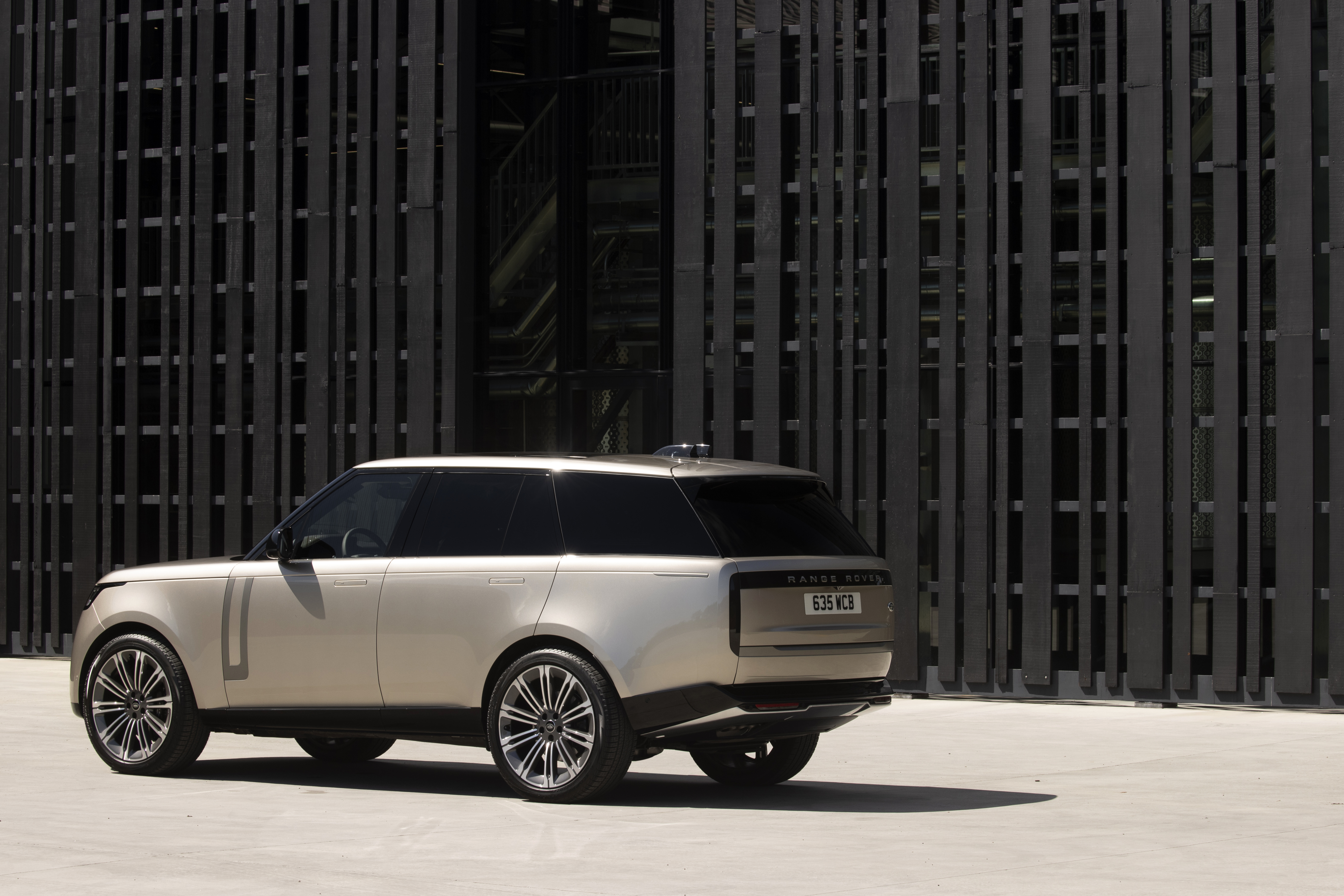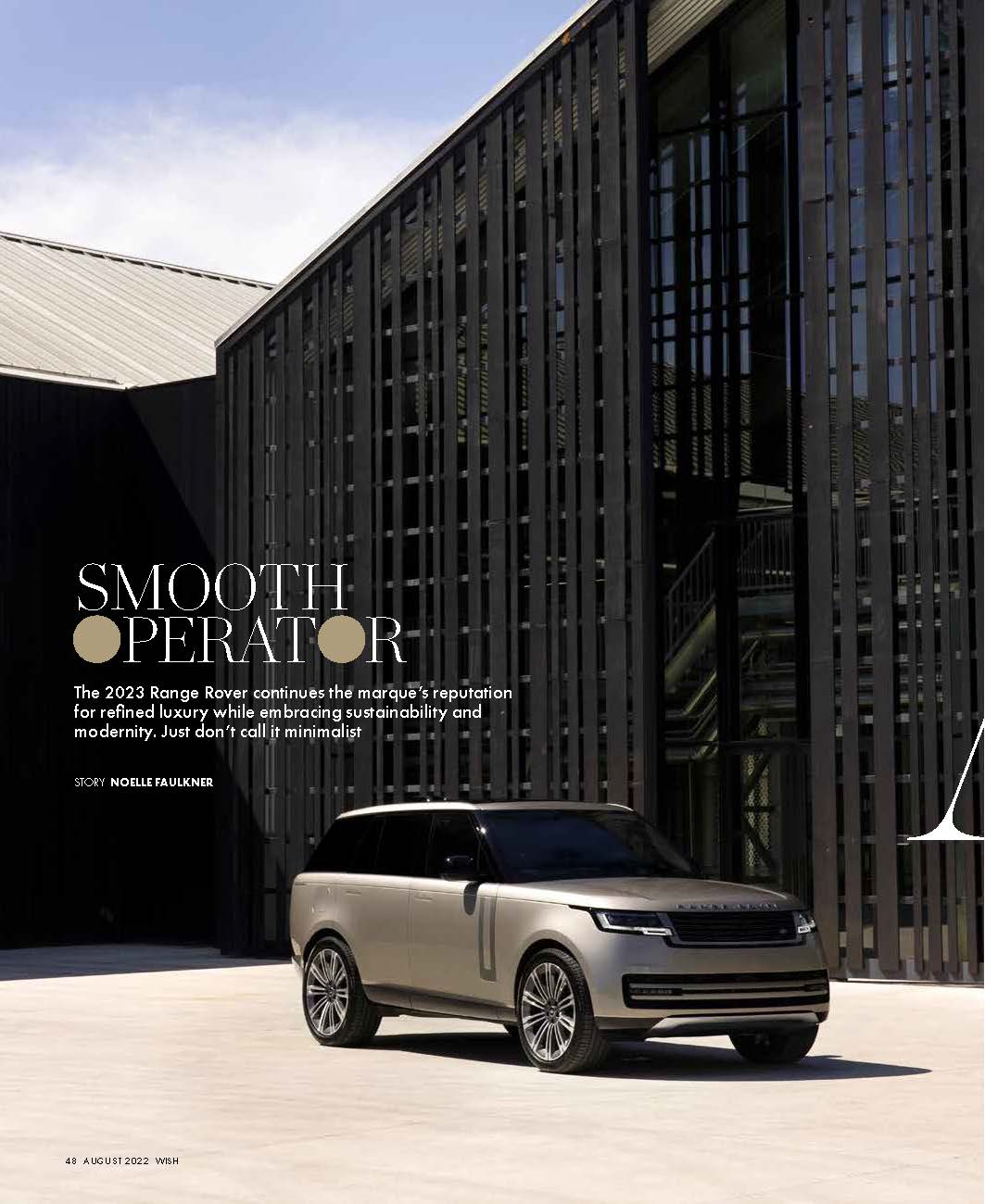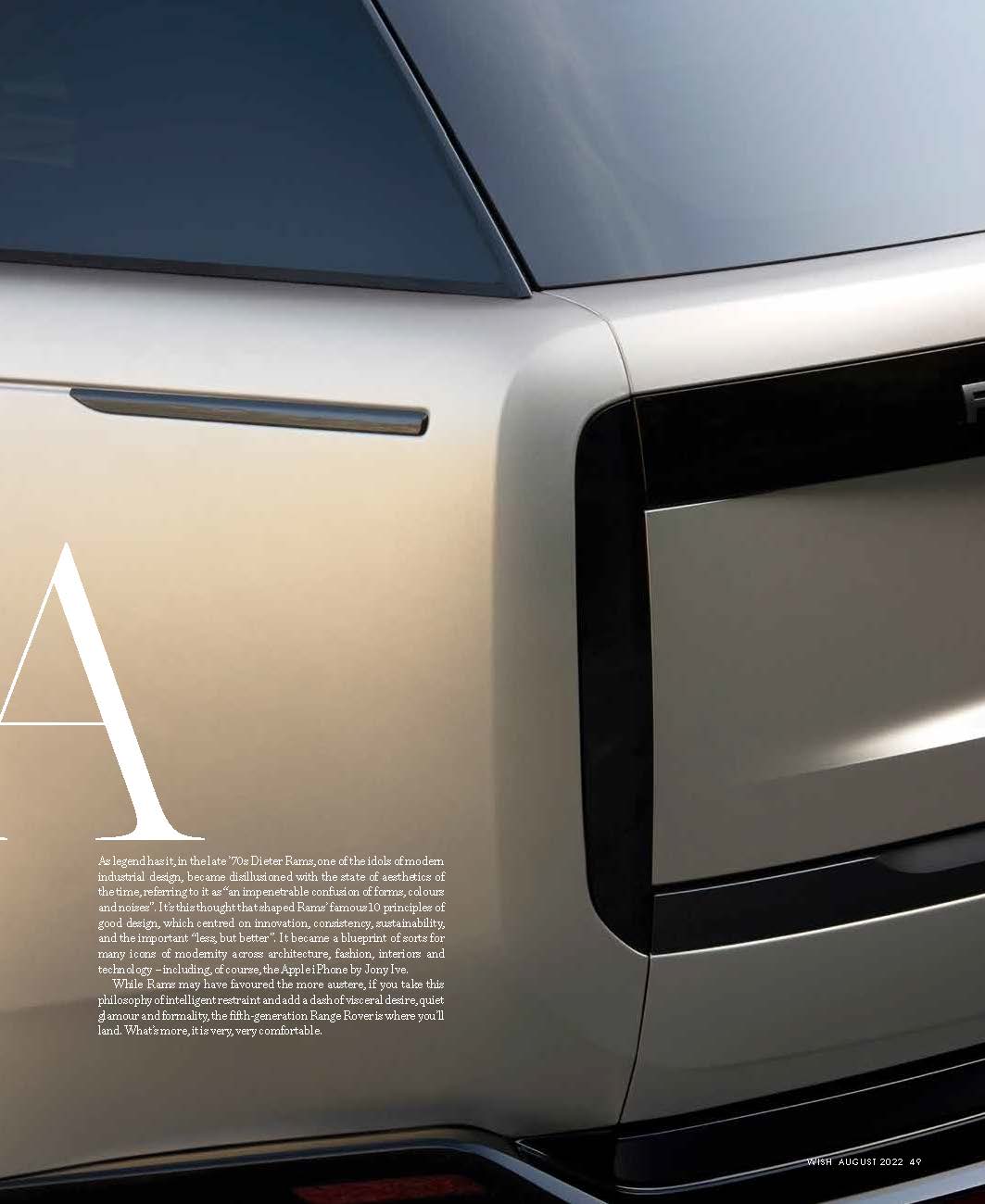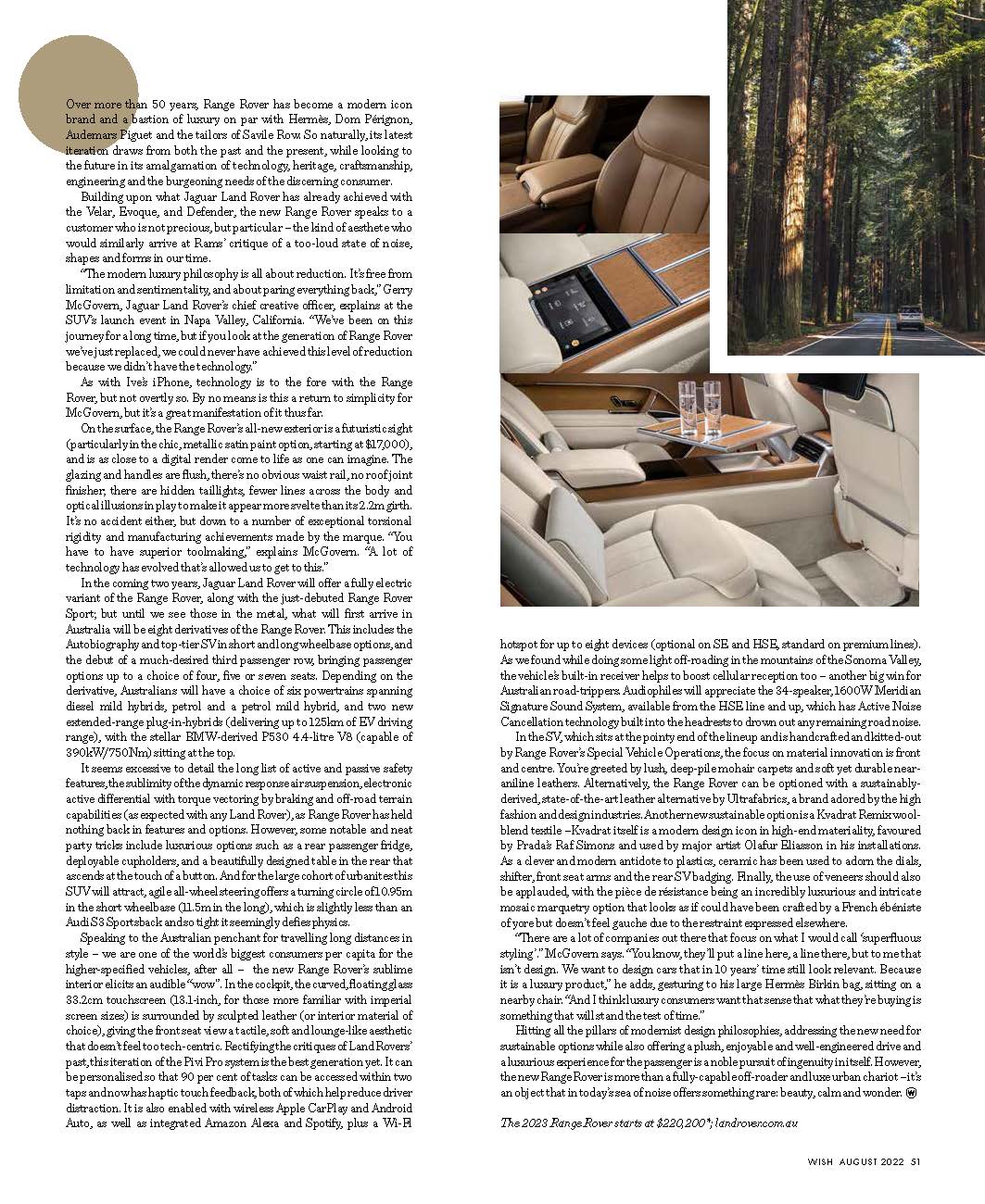Smooth Operator
The 2023 Range Rover continues the marque’s reputation for refined luxury while embracing sustainability and modernity. Just don’t call it minimalist.
Wish Magazine, The Australian, 2023 (link) (pdf)

As legend has it, in the late ’70s Dieter Rams, one of the idols of modern industrial design, became disillusioned with the state of aesthetics of the time, referring to it as “an impenetrable confusion of forms, colours and noises”. It’s this thought that shaped Rams’ famous 10 principles of good design, which centred on innovation, consistency, sustainability, and the important “less, but better”. It became a blueprint of sorts for many icons of modernity across architecture, fashion, interiors and technology – including, of course, the Apple iPhone by Jony Ive. While Rams may have favoured the more austere, if you take this philosophy of intelligent restraint and add a dash of visceral desire, quiet glamour and formality, the fifth-generation Range Rover is where you’ll land. What’s more, it is very, very comfortable.
Over more than 50 years, Range Rover has become a modern icon brand and a bastion of luxury on par with Hermès, Dom Pérignon, Audemars Piguet and the tailors of Savile Row. So naturally, its latest iteration draws from both the past and the present, while looking to the future in its amalgamation of technology, heritage, craftsmanship, engineering and the burgeoning needs of the discerning consumer. Building upon what Jaguar Land Rover has already achieved with the Velar, Evoque, and Defender, the new Range Rover speaks to a customer who is not precious, but particular – the kind of aesthete who would similarly arrive at Rams’ critique of a too-loud state of noise, shapes and forms in our time. “The modern luxury philosophy is all about reduction. It’s free from limitation and sentimentality, and about paring everything back,” Gerry McGovern, Jaguar Land Rover’s chief creative officer, explains at the SUV’s launch event in Napa Valley, California. “We’ve been on this journey for a long time, but if you look at the generation of Range Rover we’ve just replaced, we could never have achieved this level of reduction because we didn’t have the technology.” As with Ive’s iPhone, technology is to the fore with the Range Rover, but not overtly so. By no means is this a return to simplicity for McGovern, but it’s a great manifestation of it thus far. On the surface, the Range Rover’s all-new exterior is a futuristic sight (particularly in the chic, metallic satin paint option, starting at $17,000), and is as close to a digital render come to life as one can imagine. The glazing and handles are flush, there’s no obvious waist rail, no roof joint finisher; there are hidden taillights, fewer lines across the body and optical illusions in play to make it appear more svelte than its 2.2m girth. It’s no accident either, but down to a number of exceptional torsional rigidity and manufacturing achievements made by the marque. “You have to have superior toolmaking,” explains McGovern. “A lot of technology has evolved that’s allowed us to get to this.” In the coming two years, Jaguar Land Rover will offer a fully electric variant of the Range Rover, along with the just-debuted Range Rover Sport; but until we see those in the metal, what will first arrive in Australia will be eight derivatives of the Range Rover. This includes the Autobiography and top-tier SV in short and long wheelbase options, and the debut of a much-desired third passenger row, bringing passenger options up to a choice of four, five or seven seats. Depending on the derivative, Australians will have a choice of six powertrains spanning diesel mild hybrids, petrol and a petrol mild hybrid, and two new extended-range plug-in-hybrids (delivering up to 125km of EV driving range), with the stellar BMW-derived P530 4.4-litre V8 (capable of 390kW/750Nm) sitting at the top.
It seems excessive to detail the long list of active and passive safety features, the sublimity of the dynamic response air suspension, electronic active differential with torque vectoring by braking and off-road terrain capabilities (as expected with any Land Rover), as Range Rover has held nothing back in features and options. However, some notable and neat party tricks include luxurious options such as a rear passenger fridge, deployable cupholders, and a beautifully designed table in the rear that ascends at the touch of a button. And for the large cohort of urbanites this SUV will attract, agile all-wheel steering offers a turning circle of 10.95m in the short wheelbase (11.5m in the long), which is slightly less than an Audi S3 Sportsback and so tight it seemingly defies physics.
Speaking to the Australian penchant for travelling long distances in style – we are one of the world’s biggest consumers per capita for the higher-specified vehicles, after all – the new Range Rover’s sublime interior elicits an audible “wow”. In the cockpit, the curved, floating glass 33.2cm touchscreen (13.1-inch, for those more familiar with imperial screen sizes) is surrounded by sculpted leather (or interior material of choice), giving the front seat view a tactile, soft and lounge-like aesthetic that doesn’t feel too tech-centric. Rectifying the critiques of Land Rovers’ past, this iteration of the Pivi Pro system is the best generation yet. It can be personalised so that 90 per cent of tasks can be accessed within two taps and now has haptic touch feedback, both of which help reduce driver distraction. It is also enabled with wireless Apple CarPlay and Android Auto, as well as integrated Amazon Alexa and Spotify, plus a Wi-Fi hotspot for up to eight devices (optional on SE and HSE, standard on premium lines). As we found while doing some light off-roading in the mountains of the Sonoma Valley, the vehicle’s built-in receiver helps to boost cellular reception too – another big win for Australian road-trippers. Audiophiles will appreciate the 34-speaker, 1600W Meridian Signature Sound System, available from the HSE line and up, which has Active Noise Cancellation technology built into the headrests to drown out any remaining road noise.
Range Rover’s Special Vehicle Operations, the focus on material innovation is front and centre. You’re greeted by lush, deep-pile mohair carpets and soft yet durable nearaniline leathers. Alternatively, the Range Rover can be optioned with a sustainablyderived, state-of-the-art leather alternative by Ultrafabrics, a brand adored by the high fashion and design industries. Another new sustainable option is a Kvadrat Remix woolblend textile –Kvadrat itself is a modern design icon in high-end materiality, favoured by Prada’s Raf Simons and used by major artist Olafur Eliasson in his installations. As a clever and modern antidote to plastics, ceramic has been used to adorn the dials, shifter, front seat arms and the rear SV badging. Finally, the use of veneers should also be applauded, with the pièce de résistance being an incredibly luxurious and intricate mosaic marquetry option that looks as if could have been crafted by a French ébéniste of yore but doesn’t feel gauche due to the restraint expressed elsewhere.
“There are a lot of companies out there that focus on what I would call ‘superfluous styling’.” McGovern says. “You know, they’ll put a line here, a line there, but to me that isn’t design. We want to design cars that in 10 years’ time still look relevant. Because it is a luxury product,” he adds, gesturing to his large Hermès Birkin bag, sitting on a nearby chair. “And I think luxury consumers want that sense that what they’re buying is something that will stand the test of time.” Hitting all the pillars of modernist design philosophies, addressing the new need for sustainable options while also offering a plush, enjoyable and well-engineered drive and a luxurious experience for the passenger is a noble pursuit of ingenuity in itself. However, the new Range Rover is more than a fully-capable off-roader and luxe urban chariot – it’s an object that in today’s sea of noise offers something rare: beauty, calm and wonder.



